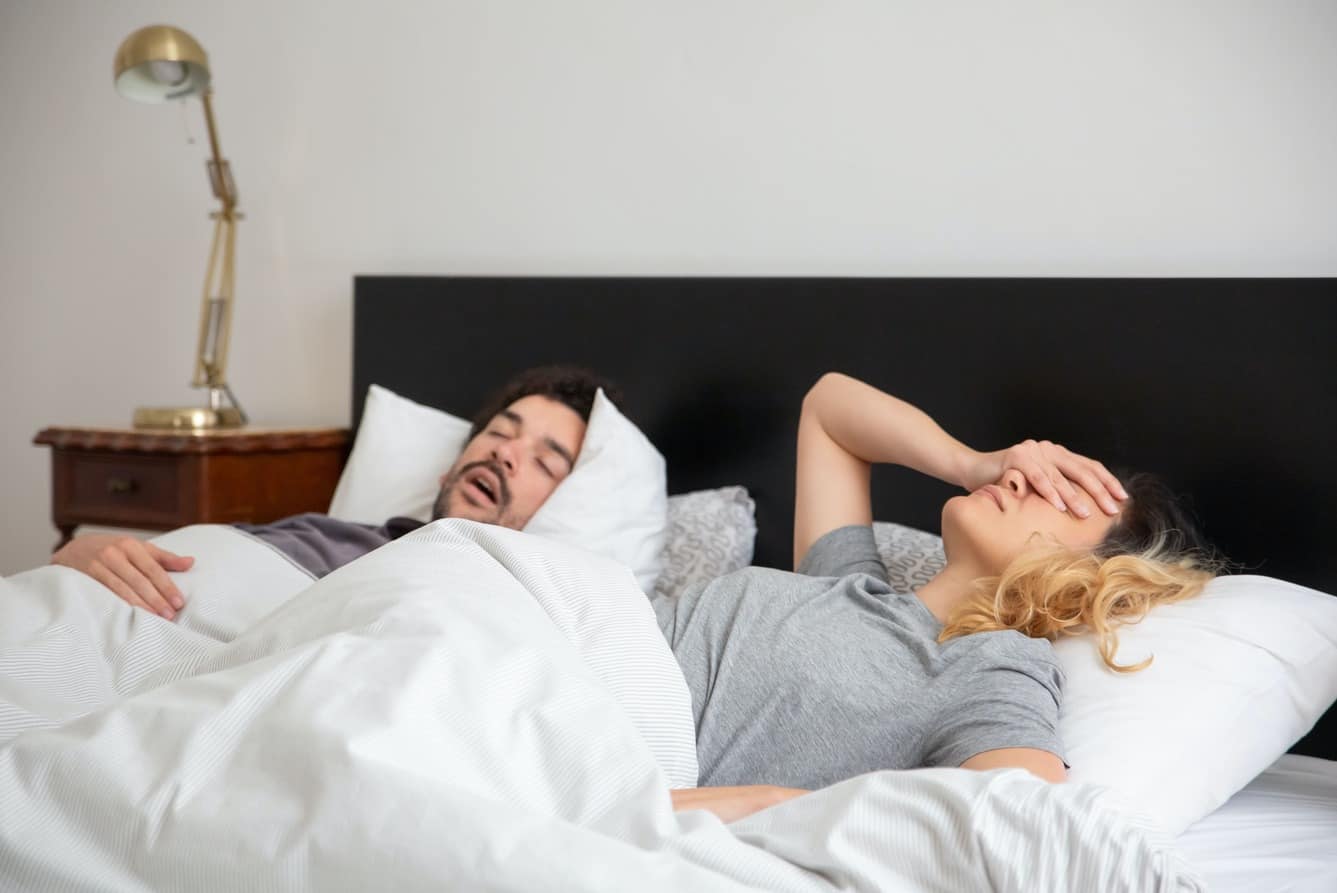In this article, we’ll help you understand obstructive sleep apnea and explain:
- The difference between obstructive sleep apnea and other types of sleep apnea
- The reasons why it is important to know whether you have obstructive sleep apnea and why you need to treat it
- The signs, symptoms, and risk factors to look out for if you suspect you might have obstructive sleep apnea
- What to do if you want to know for sure and get a medical diagnosis
- The kinds of treatments available
- What a CPAP machine is and does
- Why it is important to have a CPAP machine if you are diagnosed with obstructive sleep apnea.
Types of Sleep Apnea
As the name suggests, Obstructive Sleep Apnea (OSA) is a type of sleep apnea. But even though it is the most common type, it is not the only type. There are two other main types: Central Sleep Apnea (CSA) and Mixed Sleep Apnea, which is also known as complex sleep apnea.
What all these disorders have in common is that they cause your breathing to stop and start during sleep. However, these types of sleep apnea differ in what causes your breathing issues.
Central Sleep Apnea
In the case of central sleep apnea, the cause is related to the brain. The signals from the brain that control the muscles related to breathing are disrupted, and this causes breathing to stop and start intermittently.
Central sleep apnea is generally seen in those with such heart conditions as congestive heart failure or in folks over the age of 65. But it can also be associated with certain kinds of pain medication, antidepressants, neurological deficits, or even living at high altitudes.
Obstructive Sleep Apnea
By contrast, the most common type of sleep apnea, obstructive sleep apnea, is caused by a physical obstruction of the airways. The muscles that control your airways relax too much, which means that your throat narrows when you take an inhale, making your lungs work harder than they should.
This means that your breathing becomes very shallow and can sometimes stop entirely. Your brain eventually responds by waking you up for a moment to reopen your airway, perhaps with a gasp, snort, or body jerk, and then you fall asleep again, and the cycle repeats.
The number of times this happens per hour of sleep is known as your Apnea Hypopnea Index or AHI for short. And in fact, this process of subconsciously waking throughout a night of sleep even happens to those who aren’t diagnosed with sleep apnea.
Anything with an AHI of up to five – that’s five instances of pausing or stopping of breath per hour – is considered a safe range without the need for sleep therapy. A consistent AHI between 5 and 30 would likely lead to a diagnosis of sleep apnea, and anything over 30 AHI is considered severe sleep apnea.
For those suffering from obstructive sleep apnea, this means that your body is waking between 5 and 30 times per hour – all night, every single night!
It goes without saying that this translates to very disrupted sleep, even if you are not aware of it. In addition, the throat muscles are not the only ones that can obstruct your breathing.
Obesity, swollen tonsils and even genetic physical attributes can result in obstructive sleep apnea, as well. Most sleep specialists use the Mallampati score to determine the sizing of a person’s airway in relation to whether their soft palate or tissues are too large for the area.
Mixed Sleep Apnea
Mixed, or complex, sleep apnea is the third main type, and it includes elements of both central sleep apnea and obstructive sleep apnea and similarly comes from a mixture of their causes. Thus, if you put the last two kinds together into a hybrid super kind, you get mixed sleep apnea.
The Importance of Diagnosis
Because of sleep apnea’s relationship to breathing and, therefore, oxygen intake, the Mayo Clinic refers to it as a ‘serious sleep disorder.’ Reduced oxygen intake during sleep along with repeated disturbances to your sleep pattern can have several unwanted effects.
The most reported symptom is, unsurprisingly, daytime fatigue. Those suffering from obstructive sleep apnea regularly complain that they constantly feel tired during the day and have trouble getting out of bed in the morning. This can cause adults to have an increased risk of accidents and children to underperform in their schoolwork.
Less obvious complications associated with obstructive sleep apnea can include:
- Cardiovascular issues
- Eye problems
- Metabolic disorders
- Insulin resistance
- Increased risk of stroke or congestive heart failure
- High blood pressure
- Fertility issues within men and women.
Even neurological deficits, such as Alzheimer’s and Dementia, could be directly connected to obstructive sleep apnea. All of this means that if you do have obstructive sleep apnea, then it’s important to know that so that you can get proper treatment.
Signs, Symptoms, and Risk Factors of Sleep Apnea
The signs that you may have obstructive sleep apnea are also the symptoms of sleep apnea. Common signs and symptoms include:
- Regular daytime tiredness
- Dry or sore mouth when you wake up
- Loud snoring
- Morning headaches
- Night sweats
- Restlessness during sleep
- Waking up suddenly, feeling like you’re gasping or choking
- Low sex drive
- High blood pressure.
Of course, any of these signs can have many underlying reasons for them. But if you or your bed partner notice that you have several of these, then obstructive sleep apnea could well be the cause, and it might be worth checking out further, especially if you also have some of the risk factors associated with it.
Obstructive Sleep Apnea Risk Factors
- Being male
- Being older
- Being a person of color
- Having a family history of sleep apnea
- Smoking
- Asthma
- Diabetes
- High blood pressure
- Being overweight
- Having certain physiological features, such as a thick neck, a larger tongue, or smaller airways.
The signs and risk factors we have mentioned only provide a rough indication of whether or not you are likely to have obstructive sleep apnea. And the most common signs, such as tiredness, dry mouth, and snoring, can range from mild and occasional to severe and chronic.
You might be able to get a better idea of the likelihood of your having this condition by asking your bed partner, if you have one, about your sleeping habits at night. You can also try to change your sleeping position to see if it makes a difference.
It might also be worth considering other possible explanations for the symptoms you are experiencing. Tiredness, for example, can be the result of many things, such as high levels of stress or depression.
But if, after considering your experiences and the information in this article, you think you might have obstructive sleep apnea, there is only one way to know for sure, and that is by getting tested.
Getting a Sleep Apnea Diagnosis
Any treatment for obstructive sleep apnea first requires getting it diagnosed. To diagnose obstructive sleep apnea, a sleep study is needed.
One option is to get a sleep study done by your doctor. This may require you to spend a night in a sleep lab or to have the study done in your home via monitors.
Another option is to avoid the hassle and cost of visiting your doctor and to purchase a disposable in-home sleep study kit through Respshop.com.
Our kits come with a 15-minute online consultation with a sleep physician, and you’ll get a small device sent to you to wear on your finger while you sleep in your bed at home. The device will track data patterns over the course of multiple nights, measuring such things as your blood oxygen levels and breathing patterns, and transmit this data to your healthcare provider.
After that, your results are evaluated by a certified sleep physician who will provide you with a report and, if required, a diagnosis and prescription for treatment.
If you suspect that you have sleep apnea and wonder if you should get tested, this article will help you self-assess. And to help you choose the right type of sleep test for you, we’ve prepared this little guide.
Treating Obstructive Sleep Apnea
Let’s say you have been diagnosed with obstructive sleep apnea. What treatments are available? Well, to start with, there are some things you can do to reduce the symptoms on your own.
Speak to your doctor to find out whether your sleep apnea could be improved by making such lifestyle changes as reducing weight, limiting alcohol or caffeine, increasing exercise, or trying positional therapy.
But beyond that, something that nearly all diagnoses of obstructive sleep apnea will come with is a prescription for purchasing a CPAP device. If that’s the case, then it’s worth first talking to your insurance company to see if your health plan will offset or completely cover the cost.
But even if not, and you decide to buy a machine on your own, you will still need a prescription before you can buy one.
Now, hold on, we haven’t even told you what a CPAP machine is and how it works! Well, let’s change that, right now.
All About CPAP Machines
A CPAP machine is a device that counteracts the effects of obstructive sleep apnea. It does so by making sure your throat doesn’t excessively narrow while you sleep so your brain doesn’t wake you up.
And if your brain doesn’t wake you up repeatedly in the night, then you can get that wonderful deep and uninterrupted sleep you’ve no doubt become desperate for, and many of the troubling symptoms should disappear. Your CPAP will then become your new best friend.
How CPAP Works
All CPAP machines have two main components:
- A mask that you wear over your nostrils or nose and sometimes mouth, as well
- A device you attach to a hose on the mask that controls the airflow into your lungs and monitors your sleep patterns at the same time.
The basic principle is to make sure the pressure of the air entering your lungs is sufficient to keep your airways open and prevent you from waking up. The CPAP does this by pushing a gentle but steady flow of air through the mask and into your airways when you breathe.
That is what the PAP letters stand for Positive Air Pressure. The C stands for Continuous, and so a CPAP machine is a device that provides continuous positive air pressure, at a level chosen specifically for you, to ensure your airway stays open and your sleep remains uninterrupted.
But even though all such breathing devices come under the umbrella term ‘CPAP,’ not all of them work in the same way. There are also APAP machines, VPAP machines, and BiPAP machines. And any CPAP machine can come with a range of features and accessories that you might require, too.
A lot will depend on your individual sleep pattern, comfort requirements, and, of course, budget. We won’t go into the details of the differences between different types of machines and accessories in this article, but we have prepared this guide in case you’d like to learn about various types of CPAP machines in more depth.
But if you are looking for information with a more personal touch, then we’d love to have a chat with you and help answer any questions you might have. At Respshop.com, we have respiratory therapists, polysomnographic techs, and a nurse on staff to give you the most relevant information and advise you when making a purchase decision.
So, give us a call or visit our site, and wherever you are, sleep tight!






